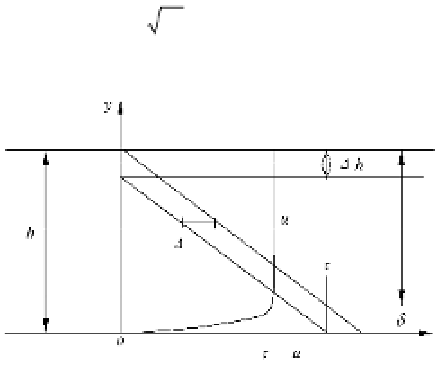Environmental Engineering Reference
In-Depth Information
2002). Similarly, the perturbation equation along the C2-family of characteristic curves is
§
W
U
·
d
(
''
u
(2
(
gh
) ))
'
¨
0
¹
(4.A11)
¸
d
t
h
©
m
In a steady laminar flow of a Bingham fluid, the shear stress W
0
is given by (4.A1):
(4.A12)
Figure 4.A1 shows the general velocity distribution of Bingham flow in an open channel. The upper
part is a plug in which the fluid flows at a uniform velocity
u
p
, which is nearly equal to the average
velocity. Only in the zone near the bed does the velocity vary, from zero to
u
p
. The thickness of the layer
is assumed to be
į
. The velocity gradient, therefore, is roughly
u
/
į
, and
W W H
0
B
§
·
d
W
u
B
¹
(4.A13)
(
''
u
(2
gh
))
'
K
¨
¸
d
t
U
h
UG
h
©
m
m
Fig. 4.A1
Velocity distribution of non-Newtonian open channel flow for a Bingham fluid
As shown in Fig. 4.A2, a perturbation that occurs at point
A
(
x
,
t
) in the
x
-
t
plane will propagate along
the characteristic curves
AB
and
AC
. For any point B on the
C
1
1
characteristic curve that passes through
the point
A
(
x
,
t
), a characteristic curve
C
2
2
intersects the
C
1
1
curve at point
B
. There is a relation between
'
u
and
at point
B
(i. e. any point on the
C
1
1
characteristic curve).
'
(2 (
gh
) )
Fig. 4.A2
Characteristic curves on the
x
-
t
plane (The abscissa is the
x
-axis and the ordinate is the time
t
-axis). If a
perturbation occurs at the point
A
, it propagates downstream along the
C
1
1
curve and upstream along the
C
2
1
curve
The area below the curves
CAB
is undisturbed. The initial perturbation has no effect on the area, and the
velocity
u
and depth
h
remain constant. Integration of Eq. (4.A11) along the
C
2
2
characteristic curve yields












Search WWH ::

Custom Search